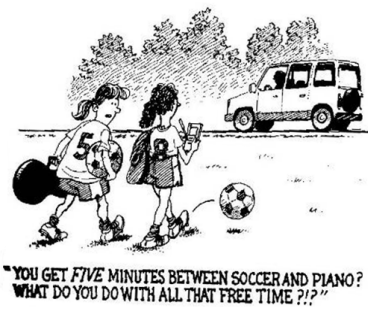Millennial StudentMillennial StudentThe Millennial Generation (also known as Generation Y) is a large group of individuals born between 1982 and 1991 and is the newest generation to have come-of-age. The Millennials grew up in a time of many great technological advancements of the modern world, they are racially and ethnically diverse, and show great signs of hope and determination. Unlike the risk-taking baby boomers or the the skeptical Generation X-ers, the 1980s gave way to an unusual generation which most educators, at the time, were unlikely prepared for when the first wave entered elementary school.
Figure 1. A cartoon depicting the life of a typical Millennial child. Millennials share a wide range of characteristics that can be ascribed to almost every member in one way or another. Most children born in the 1990s began using a computer or some sort of electronic device between the ages of five and eight. Using a computer usually helps develop a person's visual and spatial skills; this suggests that some of these individuals are intuitive visual communicators. What's more, Millennials are fascinated by technology, they enjoy using technology - whether it is a camera, a cell phone, a portable music player, or a laptop - everywhere they go and in almost everything they do. With the ability to listen, walk, type, and talk all at the same time, Millennials exhibit excellent multitasking capabilities and are always looking for ways to do more things in less time. They are able to shift their attention rapidly from one task to another and may choose not to pay attention to things that do not interest them. Millennial students are also impatient and dislike anything slow, bland or boring. They gravitate towards group work, are focused on grades and academic performance, they are family orientated, and are usually busy with extracurricular activities. Above all, Millennial students are "confident," "team oriented," "achieving," "pressured," "sheltered," and "conventional" (Howe & Strauss, 2000) - attributes that shape their personality and their awareness of societal problems in which they characteristically show great passion, often through public activism. In order to understand the Millennial generation in a classroom environment, whether it is primary school or secondary school, an educator must take into account all of the characteristics and factors associated with individuals of this distinct generation. Since Millennials are deeply committed to family, community, and teamwork, a teacher should incorporate more group work activities in their daily lesson plans. This allows students to be more active and interactive with their peers. In fact, the move between whole class, small group, and independent work is critical in maintaining continual student participation (Auger & Rich, 2007), particularly of this generation. The use of technology in the classroom may also appeal to most Millennials. Integrating technology into a classroom will help motivate these students to learn and remain interested for a longer period of time. For instance, a high school biology teacher may choose to show a video to illustrate the ciliated movement cell, rather than have students read a description from their textbook or being told directly. In addition, students of this generation may learn better if they work through an animated step-by-step tutorial using CDs provided in their textbooks, rather than to having to sit through and listen to a long lecture and then having to answer questions at the end of the chapter. Technology can also be used to remind students of any upcoming due dates or tests by creating a classroom webpage that can be maintained and updated by the teacher on a regular basis. Millennial high school students can use their cell phones, laptops or home computers to log-on to this webpage and constantly keep up-to-date, especially with their busy schedules. A webpage will highly benefit students who regularly participate in extra curricular activities, such as sports or social clubs, and have to miss class due to these circumstances. In case of an illness, students can also keep up-to-date by submitting assignments directly to their teacher using this form of technology. Finally, unlike the Generation X-ers, Millennial students are realistic; they want more structure and direction, they respond quickly and they expect rapid responses in return. If teachers do not provide enough guidance in terms of "what is going to be on the test", for instance, these students will easy get confused and not know exactly what is expected of them. An educator should, therefore, be specific and provide feedback on marked assignments and tests or wherever possible.
|


